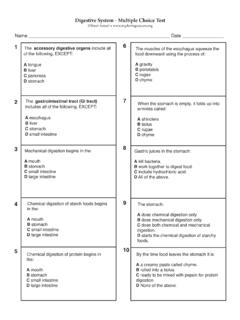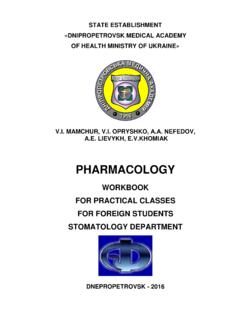Transcription of Rapid Diagnostic Centres: Vision and 2019/20 ...
1 Rapid Diagnostic Centres Vision and 2019/20 Implementation Specification NHS England and NHS Improvement Rapid Diagnostic Centres Vision and 2019/20 Implementation Specification Publishing approval number: 000614 Version number: 1 First published:25 July 2019 This information can be made available in alternative formats, such as easy read or large print, and may be available in alternative languages, upon request. Please contact 0300 311 22 33 or email stating that this document is owned by the NHS Cancer Programme, NHS England and Improvement.
2 Page 1 Information Governance Statement Organisations need to be mindful of the need to comply with the General Data Protection Regulation (GDPR), Data Protection Act 2018, the Common Law Duty of Confidence and Human Rights Act 1998 (Article 8 right to family life and privacy). Equalities Statement Promoting equality and addressing health inequalities are at the heart of NHS England s values.
3 Throughout the development of the policies and processes cited in this document, we have: Given due regard to the need to eliminate discrimination, harassment and victimisation, to advance equality of opportunity, and to foster good relations between people who share a relevant protected characteristic (as cited under the Equality Act 2010) and those who do not share it; and Given regard to the need to reduce inequalities between patients in access to, and outcomes from, healthcare services and to ensure services are provided in an integrated way where this might reduce health inequalities.
4 Page 2 Contents 1 Introduction Page 4 2 Draft Vision for RDCs Page 5 3 The RDC service model Page 6 4 Approach to implementation Page 8 5 2019/20 Implementation Specification for non-specific symptoms Page 11 6 Enablers Page 20 7 National monitoring and support Page 28 8 Appendix 1: Referral criteria and core tests Page 31 9 Appendix 2: Key local stakeholders Page 33 10 Appendix 3: Minimum data set Page 35 11 Appendix 4: Glossary Page 40 Page 3 1.
5 Introduction The commitment to roll out Rapid Diagnostic Centres (RDCs) forms an important part of our broader strategy to deliver faster and earlier diagnosis and improved patient experience. The number of people diagnosed with cancer has been rising in recent years, with a 29% increase in the number cancer diagnoses expected between 2016-2028. To ensure we maintain standards, whilst providing a diagnosis to more people, we will need to transform the way we deliver Diagnostic services, including diagnostics for cancer. RDCs will support the new Faster Diagnosis Standard (FDS), which will be introduced from April 2020.
6 RDCs will also complement work to improve screening programmes, augment the potential of artificial intelligence (AI) and genomic testing, and utilise Primary Care Networks to improve early diagnosis in their localities. The purpose of this document is to (1) outline the draft Vision and approach for how RDCs will develop and support the transformation of cancer diagnosis services over time and (2) provide an implementation specification for Cancer Alliances to begin setting up RDCs in 2019/20 . This specification is to ensure the phased implementation of RDCs across England is aligned to and achieves the end Vision .
7 We will work with Cancer Alliances and local providers to iterate and standardise the RDC service model as we learn from implementing them in practice. Further guidance on the approach for 2020/21 onwards will be provided in the Autumn. In 2019/20 , all Cancer Alliances are expected to set up at least one RDC for patients with non-specific symptoms which could indicate cancer; as well as for a cohort of patients with site-specific symptoms who are currently served by an underperforming two week wait or 62 day pathway. The RDC service model has evolved from the Multidisciplinary Diagnostic Centre (MDC) service model.
8 MDCs tested service models for non-specific symptoms and were piloted over two years as part of the Accelerate Coordinate Evaluate (ACE) programme, a partnership between Cancer Research UK, Macmillan Cancer Support and NHS England. More detail on the ACE programme and its findings can be found here. Page 4 2.
9 Draft Vision for RDCs We are setting an ambitious Vision for RDCs. In time, RDCs will offer: A single point of access to a Diagnostic pathway for all patients with symptoms that could indicate cancer; A personalised, accurate and Rapid diagnosis of patients symptoms by integrating existing Diagnostic provision and utilising networked clinical expertise and information locally. By implementing RDCs, we aim to contribute to the following objectives: To support earlier and faster cancer diagnosis by assessing patients symptoms holistically and providing a tailored pathway of clinically relevant Diagnostic tests as quickly as possible, targeting and reducing any health inequalities that may currently exist; To create increased capacity through more efficient Diagnostic pathways by reducing unnecessary appointments and tests.
10 To deliver a better, personalised Diagnostic experience for patients by providing a series of coordinated tests and a single point of contact. To reduce unwarranted variation in referral for, access to and in the reliability of relevant Diagnostic tests by setting standards for RDCs nationally, mandating consistent data collection to enable benchmarking and providing regional support to roll out RDCs; To improve the offer to staff with new roles which offer development opportunities, greater flexibility and a chance to work in innovative ways. The implementation of RDCs will be supported by the roll-out of pathology and imaging networks; investment in new equipment, subject to capital availability; and workforce reforms in line with the People Plan1.

















